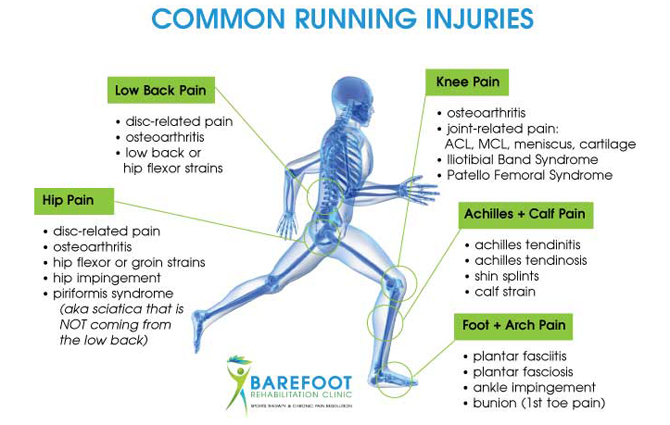
10 Jul Avoid the Most Common Running Injuries
Author’s Note: This post is for the die-hard runners out there as we discuss common running injuries. My intent is to educate you just enough about them so that you can fully prepare yourself to avoid them, living a long, injury-free life. We will not dive deep into any one condition here. If you’re not able to manage your running injury, Barefoot Rehab can help you just like we helped our friend Greg run an Ironman. We’re always open to discussing your running injury for your 5K, triathlon, or marathon on the phone just to see if you need a diagnosis and to have your adhesion removed. If you’re able to manage your pain/injury yourself, all the power to you!
—
If you’re a runner, I’ll make a few assumptions that I am very confident are true.
You LOVE to run.
It’s your stress management, fitness activity, + spiritual meditation all in one. You crave it on a daily basis, hungry to get in the flow of stride-after-stride, breath-after-breath. After running, you feel full + wholesome in a way that only running can bring you.
You HATE those times when you can’t run.
It’s almost like your a child and you’ve lost your favorite teddy bear. You’re besides yourself about what to do. Those things that you get from running … your stress reduction, calorie burn, + mindfulness practice … are suddenly thrown up into chaos. This turmoil causes you to experience enormous anxiety over what to do as your body attempts to recover and heal so you can do what you love to do: RUN.
You’ll do whatever you can do to run for as many years of your life as possible.
I bet that if you run, you’re somewhat of a perfectionist. Meaning, you’re probably successful in many areas of your life. When it comes to your running career, you’ll do whatever it takes to run faster, more efficiently, and for as long as possible. After all, it’s running that gives you the energy and fuel to perform and succeed in your career, familial relationships, and other endeavors that call to you.
Before we discuss the injuries, let’s point at the natural principles that runners tend to break.
Principle #1: The Only Healthy Fitness Activity is One That Always Changes
The only healthy posture is one that is always changing. ~Stu McGill
We humans are hunter-gatherers when it comes to our genes. The physical lifestyle we are meant to live is one of infinite activities: hunting, gathering, cooking, cleaning, setting up and taking down teepees, fighting, wrestling, going to war, having sex, chasing the kids, dancing around the fire, + laying to sleep at night to recover.
Today, we break this principle in first grade by sitting for, what? Four hours a day? Maybe six?
At work, perhaps you sit for eight hours a day? If you’re a desk warrior, read our good friend Dr. Scott Mill’s Work Station Recommendations. 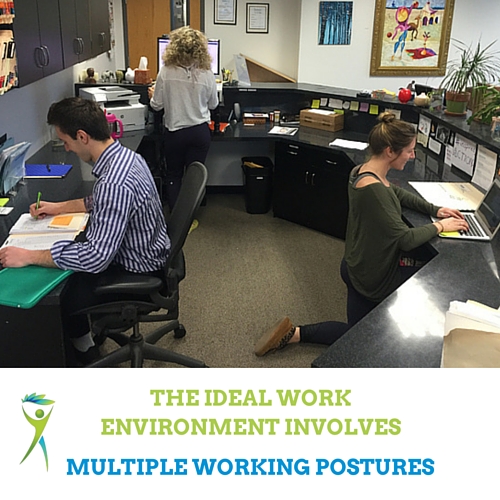
Or maybe, you type all day? Or text how many times?
In the same way, your movement practice results in a repetitive movement known as running.
Don’t get me wrong, running is a healthy movement and one that we’re supposed to do as human beings. How else would we catch that deer on the horizon in order to eat?
Take running out of context and we’re in trouble. Run, only to go back to the death trap known as a chair, + the risk of disaster (or significant injury) goes up through the roof.
Principle #2: The Plant Doesn’t Flower Until The Roots + Stem Are Strong Enough to Handle the Blossoming
You can’t put the cart before the horse. You can’t flower until your roots + stem have developed their foundation first.
Notice:
- The ease with which this is able to be done.
- When I step out, the heel hits the ground first.
- When I step back, the heel leaves the ground last.
- The upright posture.
- The knee lined up over the second toe.
You try it.
Now, ask yourself if you hit all of the above points.
The ability to lunge well is the root to your ability to run with ease into the future. The lunge allows you to experience the flower + fruits that running give you.
Below are the most common running injuries we’ve seen in our chronic pain resolution practice. Below, I list the most common running injuries + bang-for-your-buck tests to learn more about the pain that is stopping you from running (if it hasn’t already). The tests listed won’t take more than a minute or two to perform, although it may take five to ten minutes to read what the test is checking for.

1. Foot + Arch Pain
Types of Foot + Arch Pain:
- plantar fasciitis
- plantar fasciosis
- ankle impingement
- bunion (1st Toe pain)
If you’re readying this, you probably didn’t grow up running shoeless on the African savannah. That means that as soon as you were able to walk, you were thrust into shoes that altered your natural biomechanics, adding artificial support to a heel that doesn’t necessarily need it.
Maybe you always ran as a five, ten, + fifteen year-old, running through today without a significant break in your running career. If this is you, you’re probably more biomechanically balanced than your average human “bear”.
But if you’ve lived the standard american lifestyle, then putting all of the running stresses on your feet, which aren’t used to so much, is the reason why your foot is the #1 running injury location out there.
2. Achilles + Calf Pain
Types of Achilles + Calf Pain:
- achilles tendinitis
- achilles tendinosis
- shin splints
- calf strain
Test Yourself:
Next up the chain from your foot is the achilles + calves. 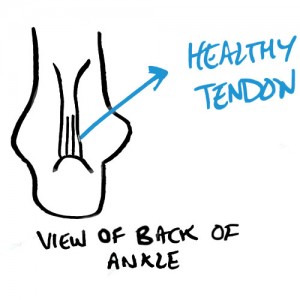
In our bodies, the achilles acts like a rubber band to elastically store energy when dormant + release it in the flow of walking + running. When all of the gears of our bodies are working properly, this costs the achilles very little energy + stress.
But when the achilles is asked to perform overtime through compensation (restricted hip extension, excessive heel striking, restricted ankle dorsiflexion, etc.), it can only work overtime for so long.
3. Low Back Pain
Types of Low Back Pain:
- disc-related pain
- osteoarthritis
- low back or hip flexor strains
Test Yourself:
- Touch Your Toes Test
- Cat-Cow Pencil Test
- Lunge Stretch Test
- Thigh to Chest Test
Remember how we spoke about how much you sat in the past and continue to sit in the future?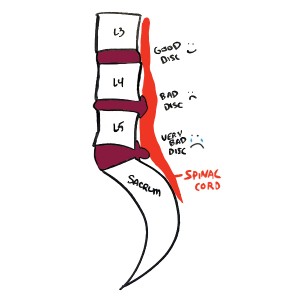
Well, your low back is mad at you. Failure to restore low back ranges of motion, only to grind away on your spinal facets joints and disc with the low-intensity repetition of each stride as you jog, leaves the risk of increased low back pain + injury relatively high.
The herniated disc you have is exactly that. A herniated disc. It isn’t so severe to be a death sentence. But it should not be ignored either. Generally speaking, I really don’t care if your disc is herniated.
You simply need to know how to do what you love,while managing stress to the spine, providing your low back pain relief when needed.
4. Hip Pain
Types of Hip Pain:
- disc-related pain
- osteoarthritis
- hip flexor or groin strains
- hip impingement
- piriformis syndrome (aka sciatica that is NOT coming from the low back)
- Touch Your Toes Test – if you are really tight in one calf, but not the other calf, then this data point is highly indicative of piriformis syndrome.
- Lunge Stretch Test
- Thigh to Chest Test
The hip is the strongest joint in your body.
When it goes dormant due to excessive sitting, causing your nervous system to put the brakes on your glutes + hamstring muscles, it makes sense that the joint will take the brunt of the stress that your really strong glutes aren’t taking anymore.
Do you have a pinch in the front of your hip when you run, walk, or sit?
Then, your hip joint gears are already pinching and taking too much stress.
5. Knee Pain
Types of Knee Pain:
- osteoarthritis
- joint-related pain: involves the ACL, MCL, meniscus, or cartilage
- Iliotibial Band Syndrome
- Patello Femoral Syndrome
Generally, the knee joint is a simple, secondary joint that is often painful way after the ankle or the hip joint are not working properly. Therefore, it’s important to test the ankle + hip along with the knee (see above for those tests).
Unless there was a trauma in your past, in practice, we always look down or up-stream from your knee to determine why your knee is crying out.
If your knee has gotten so bad that your knee joint (specifically, your meniscus is stuck like a wallet in the door hinge) is affected, it’s best you own this about your body.
With knowledge comes power.
With knowledge about what’s going on it with your body, you’re way ahead of the game when it comes to treating your body with respect and making sure you honor it as you continue your running career.
Now, what do you do to continue increasing your running capacity?
1. Restore Ranges of Motion as much as possible either yourself (through stretching or strengthening) or with a trust manual therapist.
The normal ranges of motion in all of the tests above are those required to be a human-being and do normal human-being movements. Therefore, I strongly advise doing whatever you can to restore those ranges.
Having a restriction in any joint is like having high triglycerides for your heart. No one argues the doctor’s advice to go on Lipitor because of the high-risk of heart attack.
Shouldn’t we reduce the risk of a joint-replacement surgery at age 50 or 60 by restoring joint range of motion now?
If whatever you do does not increase you range of motion in a month given your consistent effort, stop. You’re wasting your time. Get a diagnosis!
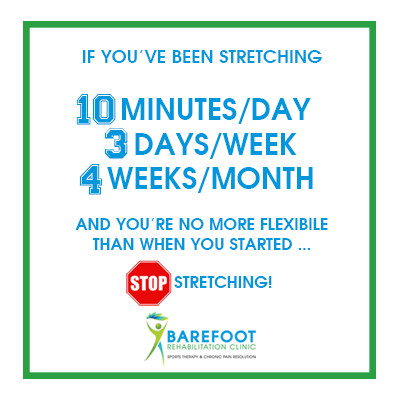
2. Lunge Every Day
If you enjoy your ability to walk or run, then show your body some gratitude by lunging well.
3. Monitor Load + Capacity
If you’re really tight after a specific run, some tissue is overused + needs more time to recover. Even if your tightness isn’t pain, your nervous system is trying to tell you that your load exceeded capacity. Load is how much work you do. Capacity is how much work you are ABLE to do.
Why not just wait a day or two until it’s less tight again?
Or if that tissue feels weak, maybe you can strengthen it with some cross-training?
To maintain fitness and joint health, there’s a fine line to how much you should be loading your body. Not too much, not too little.
 How have injuries stopped you from running? What has your experience been like as you navigate your beloved running with injuries that prevent you from doing it? What has your experience been like with health care providers who help you with your common running injuries?
How have injuries stopped you from running? What has your experience been like as you navigate your beloved running with injuries that prevent you from doing it? What has your experience been like with health care providers who help you with your common running injuries?

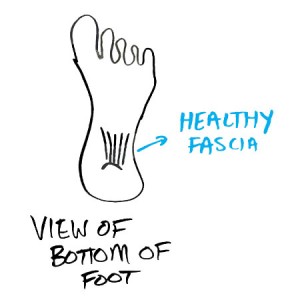
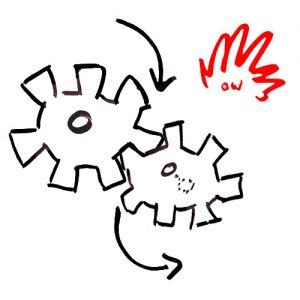
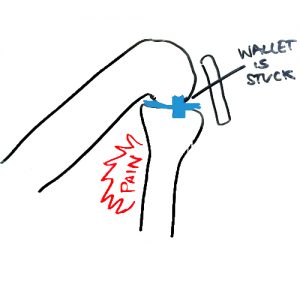
1Comment